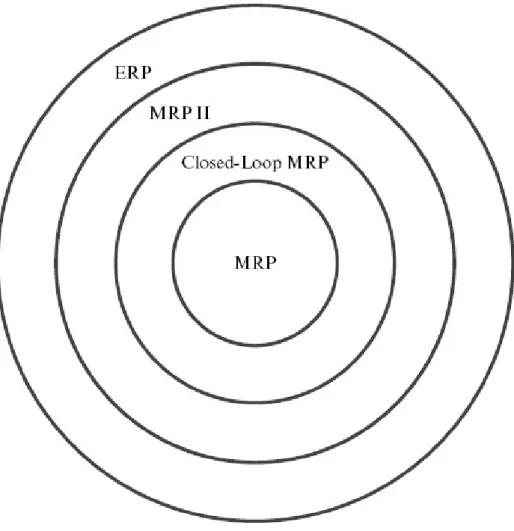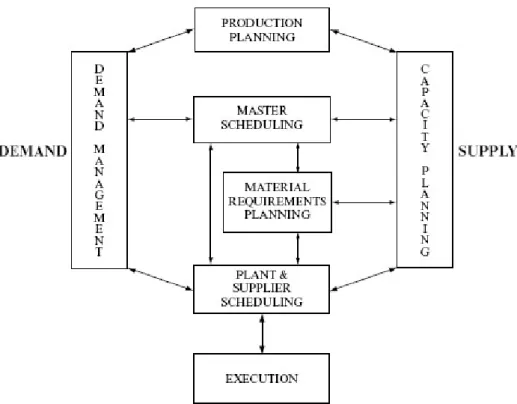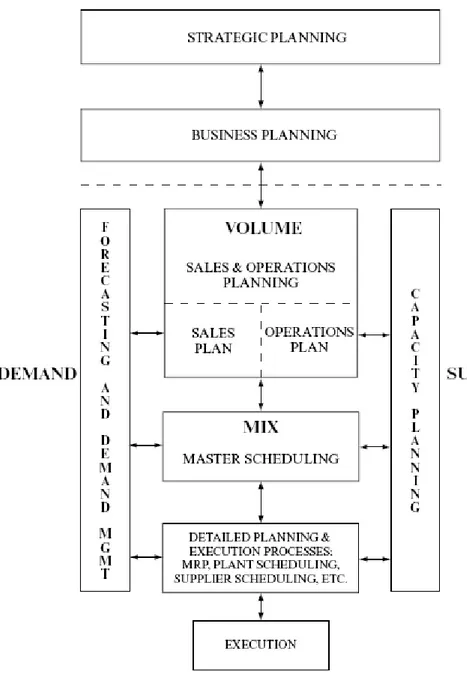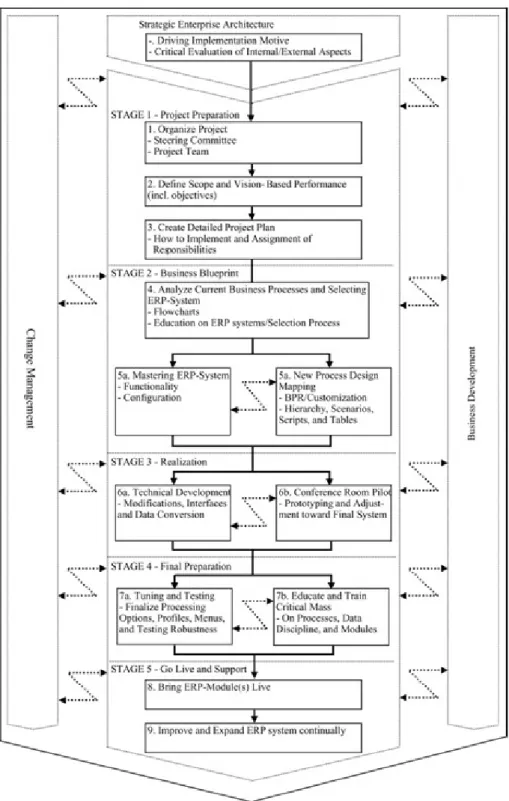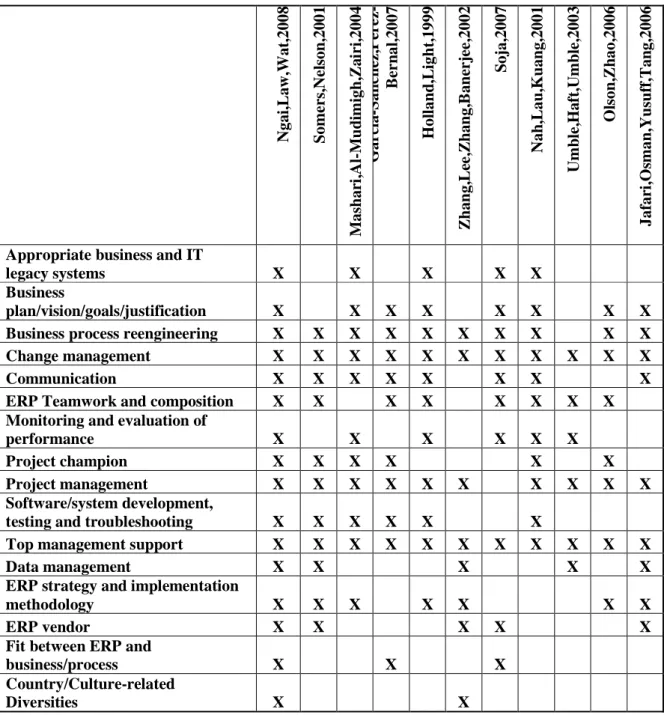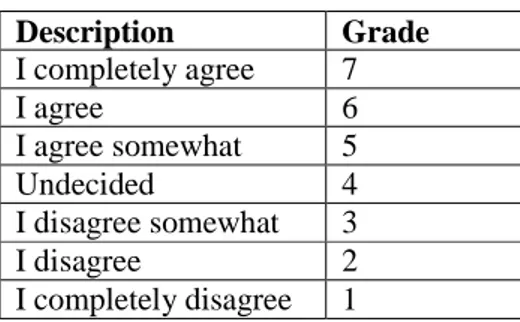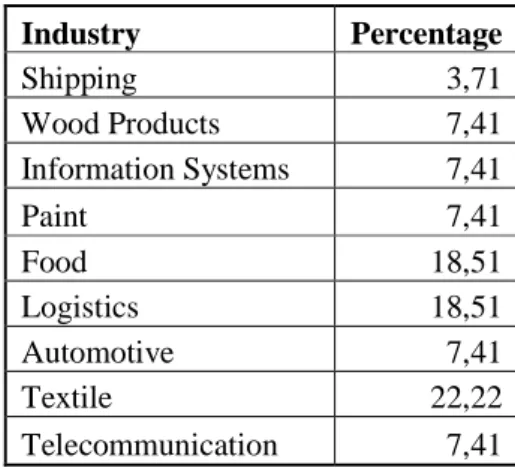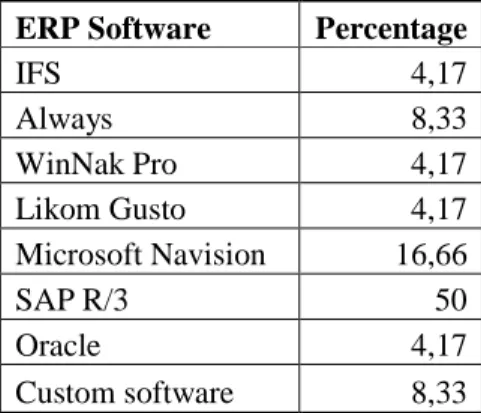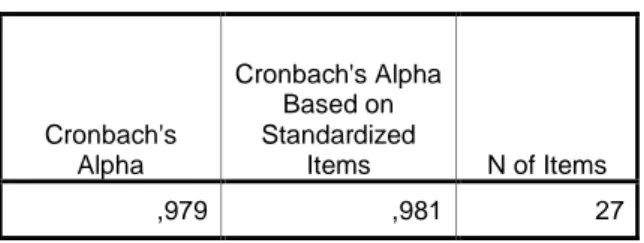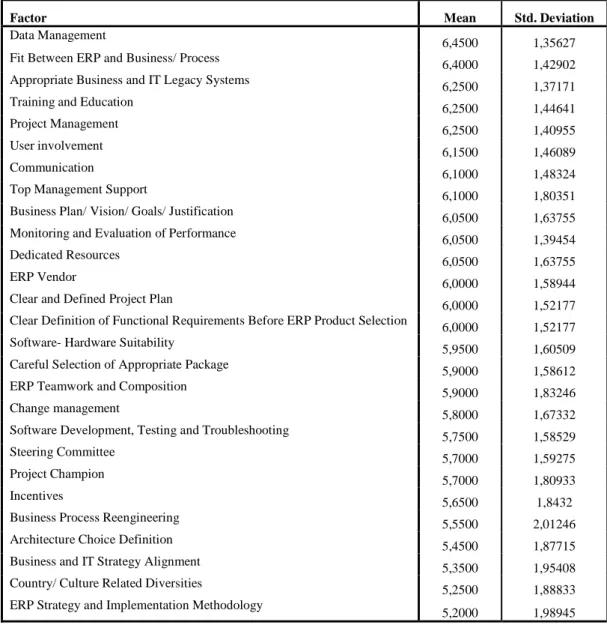T.C.
B A H Ç E Ş E H Đ R Ü N Đ V E R S Đ T E S Đ
FACTORS AFFECTING IMPLEMENTATION OF
ENTERPRISE RESOURCE PLANNING SYSTEMS AND
TURKEY CASE STUDY
Graduation Thesis
ERDEM ERZURUM
T.C.
B A H Ç E Ş E H Đ R Ü N Đ V E R S Đ T E S Đ
THE INSTITUTE OF SCIENCE
INFORMATION TECHNOLOGIES
FACTORS AFFECTING IMPLEMENTATION OF
ENTERPRISE RESOURCE PLANNING SYSTEMS AND
TURKEY CASE STUDY
Graduation Thesis
ERDEM ERZURUM
Supervisor: ASST. PROF. F. TUNÇ BOZBURA
Co-Supervisor: ASSOC. PROF. ERKAN BAYRAKTAR
Co-Supervisor: ASST. PROF. AHMET BEŞKESE
T. C.
B A H Ç E Ş E H Đ R Ü N Đ V E R S Đ T E S Đ
INSTITUTE OF SCIENCE
INFORMATION TECHNOLOGIES
Name of the thesis: Factors Affecting Implementation of Enterprise Resource Planning Systems and Turkey Case Study
Name/Last Name of the Student: Erdem ERZURUM Date of Thesis Defense: 05.09.2008
The thesis has been approved by the Institute of Science.
Prof. Dr. Bülent ÖZGÜLER Director
___________________
I certify that this thesis meets all the requirements as a thesis for the degree of Master of Science.
Asst. Prof. F. Tunç BOZBURA Program Coordinator ____________________
This is to certify that we have read this thesis and that we find it fully adequate in scope, quality and content, as a thesis for the degree of Master of Science.
Examining Committee Members Signature
Asst. Prof. F. Tunç BOZBURA ____________________
Asst. Prof. Ömer Lütfi UYANIK ____________________
ACKNOWLEDGEMENTS
Firstly, I would like to thank my master for his help and guidance.
I would like to express my gratitude to my supervisor F. Tunç Bozbura and my co-supervisors Erkan Bayraktar and Ahmet Beşkese for encouraging and challenging me throughout my thesis studies.
I also thank Ş. Çağlar Toklu for his help on many different topics throughout my thesis studies. We cannot blame the blind; they don’t have eyes to see.
I give my special thanks to Hirose Daisuke, who educated me on the edge of his sword and shaped my body and mind. I thank Tomi Hirose for her benignity.
ii
ABSTRACT
FACTORS AFFECTING IMPLEMENTATION OF ENTERPRISE RESOURCE PLANNING SYSTEMS AND TURKEY CASE STUDY
Erzurum, Erdem Information Technologies Supervisor: Asst. Prof. F. Tunç Bozbura
September 2008, 50 pages
Especially in 1990’s, many firms in Turkey began to implement Enterprise Resource Planning systems, in order to gain comparative advantage against their competitors. Even though successful implementations can be observed in 2000’s, problems during implementation process or post-implementation came to foreground especially with small and medium-sized enterprises. As stated in previous researches, unsuccessful implementations cause serious financial costs, or even bankruptcy. Therefore, knowing what affects the success of implementation process is crucial for organizations that undertake implementation of a new system. This research aims to point out the critical success factors that affect the implementation process in Turkey. A questionnaire has been formed and some system users of various positions have been asked to fill them. Questionnaire answers have been evaluated and statistically analyzed to find out the critical success factors and their order of importance as perceived by system users in Turkey.
Key Words: enterprise resource planning, critical success factors, ERP system users
iii
ÖZET
KURUMSAL KAYNAK PLANLAMA SĐSTEMLERĐNĐN UYGULANMASINI ETKĐLEYEN FAKTÖRLER VE TÜRKĐYE OLAY ĐNCELEMESĐ
Erzurum, Erdem
Bilgi Teknolojileri Tez Danışmanı: Yrd. Doç. Dr. F. Tunç Bozbura
Eylül 2008, 50 sayfa
Özellikle 1990’lı yıllarda, rakipleri karşısında rekabet avantajı kazanmak üzere birçok firma Kurumsal Kaynak Planlama sistemleri uygulamaya başladı. 2000’li yıllarda başarılı uygulamalar gözlemlenebilse bile, özelikle küçük ve orta büyüklükteki işletmelerde uygulama sırasında ve uygulama sonrası problemler ön plana çıkmıştır. Önceki araştırmalarda belirtildiği gibi, başarısız uygulamalar ciddi finansal maliyetlere yol açmakta, hatta iflasa bile sebebiyet vermektedir. Bu sebeple, yeni bir sistemin uygulanmasını üstlenen organizasyonlar için uygulama sürecinin başarısını neyin etkilediğini bilmek çok önemlidir. Bu araştırma Türkiye’de uygulama sürecini etkileyen kritik başarı faktörlerini göstermeyi amaçlamaktadır. Başarı faktörleri hakkında bir anket oluşturulmuş ve çeşitli konumlardaki bazı system kullanıcılarından anketi doldurmaları istenmiştir. Anket sonuçları değerlendirilip istatistiksel olarak analiz edilerek Türkiye’deki system kullanıcıları tarafından algılanan kritik başarı faktörleri ve önem sıraları bulunmaya çalışılmıştır.
Anahtar Kelimeler: kurumsal kaynak planlama, kritik başarı faktörleri, ERP sistem kullanıcıları
iv
TABLE OF CONTENTS
ACKNOWLEDGEMENTS ... i ABSTRACT ... ii ÖZET ...iii TABLE OF CONTENTS ... iv LIST OF TABLES ... viLIST OF FIGURES ... vii
LIST OF ABBREVIATIONS... viii
1. INTRODUCTION ... 1
2. ENTERPRISE RESOURCE PLANNING SYSTEMS ... 3
2.1. DEFINITION OF ERP ... 3 2.2. EVOLUTION OF ERP ... 3 2.2.1. MRP ... 5 2.2.2. Closed-Loop MRP ... 6 2.2.3. MRP II ... 8 2.2.4. ERP ... 8
2.3. BENEFITS AND COSTS OF IMPLEMENTING ERP ... 10
2.4. IMPLEMENTATION ... 10
3. CRITICAL SUCCESS FACTORS IN ERP IMPLEMENTATION ... 14
3.1 APPROPRIATE BUSINESS AND IT LEGACY SYSTEMS ... 16
3.2 BUSINESS PLAN/VISION/GOALS/JUSTIFICATION ... 16
3.3 BUSINESS PROCESS REENGINEERING ... 16
3.4 CHANGE MANAGEMENT ... 17
3.5 USER INVOLVEMENT ... 17
3.6 TRAINING AND EDUCATION ... 18
3.7 COMMUNICATION... 18
3.8 DATA MANAGEMENT ... 19
3.9 ERP STRATEGY AND IMPLEMENTATION METHODOLOGY ... 19
v
3.11 CAREFUL SELECTION OF APPROPRIATE PACKAGE ... 20
3.12 SOFTWARE – HARDWARE SUITABILITY ... 21
3.13 ERP TEAMWORK AND COMPOSITION ... 21
3.14 STEERING COMMITTEE ... 22
3.15 INCENTIVES ... 22
3.16 ERP VENDOR ... 23
3.17 MONITORING AND EVALUATION OF PERFORMANCE ... 23
3.18 PROJECT CHAMPION ... 24
3.19 PROJECT MANAGEMENT ... 24
3.20 CLEAR AND DEFINED PROJECT PLAN ... 25
3.21 DEDICATED RESOURCES ... 25
3.22 SOFTWARE DEVELOPMENT, TESTING AND TROUBLESHOOTING ... 26
3.23 ARCHITECTURE CHOICE DEFINITION ... 26
3.24 CLEAR DEFINITION OF FUNCTIONAL REQUIREMENTS BEFORE ERP PRODUCT SELECTION ... 26
3.25 TOP MANAGEMENT SUPPORT ... 27
3.26 FIT BETWEEN ERP BUSINESS/PROCESS ... 27
3.27 COUNTRY/CULTURE RELATED DIVERSITIES ... 28
4. RESEARCH ... 29
4.1. PURPOSE AND IMPORTANCE OF THE RESEARCH ... 29
4.2. RESEARCH METHOD SELECTION ... 29
4.3. APPLICATION ... 30
4.4. SURVEY DESIGN ... 30
4.5. STATISTICAL ANALYSIS OF SURVEY RESULTS ... 30
4.6. FACTOR ANALYSIS ... 35 5 CONCLUSION ... 37 REFERENCES ... 39 APPENDIXES ... 41 APPENDIX A ... 42 CURRICULUM VITAE ... 50
vi
LIST OF TABLES
Table 3.1: Cross-Reference Table of Critical Success Factors ... 15
Table 4.1: Seven Point Likert Scale ... 29
Table 4.2: Distribution Table of Companies by Industry ... 31
Table 4.3: Distribution Table of User Experience ... 31
Table 4.4: Distribution Table of Modules Used Mainly by Survey Respondents ... 32
Table 4.5: Distribution Table of ERP Software Used By Survey Respondents ... 32
Table 4.6: Distribution Table of Employee Numbers in Survey Respondents’ Organizations ... 33
Table 4.7: Reliability Analysis ... 33
Table 4.8: Mean Rankings of Critical Success Factors ... 34
vii
LIST OF FIGURES
Figure 2.1: Evolution of ERP ... 5
Figure 2.2: Closed-Loop MRP ... 7
Figure 2.3: Enterprise Resource Planning ... 9
viii
LIST OF ABBREVIATIONS
Enterprise Resource Planning System : ERP
Material Requirements Planning : MRP
Manufacturing Resource Planning : MRP II
Business Process Reengineering : BPR
1.
INTRODUCTION
With the advances in communication and transportation in last decades and the ever-growing globalization trend, firms face a more difficult challenge in the business environment today when compared to previous eras. Economy is now providing consumers the opportunity to select goods and services from a wide range of international companies. These changes force firms to keep their costs low while supporting at least a certain level of quality. Since every firm has to maintain these minimum standards now, a firm has to differentiate itself from its competitors if it wants success. There is a new rule for the enterprise; one has to be able to make the right decisions as quick as possible in order to make that change and survive in the market. Information is the key to survival under the new conditions. Only with the right information can a firm make decisions, plan, control and produce a good or service that can find a demand in the market. To obtain the right information in the fastest way and with minimum corruption possible, firms now have to integrate many of their separate business processes.
Enterprise resource planning systems were found and used as a solution by firms to be able to satisfy these new necessities. Enterprise resource planning systems integrate and enable managing, planning and controlling of many of the separate business processes an organization has. It collects the business data from different departments of an organization in one database under one application. It ensures that from these data necessary information can be derived, obtained or transferred safely, in time and without getting corrupted. In 1990’s, many Turkish firms get to enterprise resource planning systems implementation projects to keep their competitive positions. The benefits of a successful implementation are high and most desirable, like lower costs, improved services, more reliable decision support etc. But some of these firms failed. Failure means very high costs and even bankruptcy. Since the implementation of an ERP system necessitates changes in business processes, a case of failure also means loss of some part of the business.
2
Researchers turned their eyes on the subject long before Turkish firms did. A large number of academic studies performed on the success of ERP implementations can be found in literature. These previous studies state that those firms who failed in their implementation process ignored various factors. These factors, which are critical by means of the success of the implementation project, are referred as “critical success factors” or CSFs, for short. In the next chapter of this study, the definition of ERP is discussed first, and its historical evolution is explained. The progress since the surfacing of Material Requirements Planning until today is briefly mentioned. Next, ERP implementation benefits and risks are pointed at. The reasons of implementing a new ERP system are given. The last part of the chapter clarifies the three implementation phases of a new system. Chapter 3 is all about the CSFs. 27 CSFs found in literature review are selected. Purpose and importance of this research, research method selection, survey design and application and survey result analysis are revealed in Chapter 4. The last chapter concludes the study, evaluation of results and some suggestions for the future studies are made.
3
2.
ENTERPRISE RESOURCE PLANNING SYSTEMS
2.1. DEFINITION OF ERP
The enterprise resource planning system is a generic term for a broad set of activities supported by multi-module application software that helps organizations to manage their resources (Ngai et al. 2008). This definition, though informative, does not emphasize integration. As a major characteristic of ERP systems, an ERP system integrates all desired business processes. One of the most commonly made mistakes about ERP is considering it only as software. But in truth, ERP is about business processes.
The basic architecture of an ERP system builds upon one database, one application and a unified interface across the entire enterprise. An entire organization is therefore able to operate under one application standard where all applications serving human resources, accounting, sales, manufacturing, distribution, and supply-chain management aspects are firmly integrated (Al-Mashari et al. 2003).
2.2. EVOLUTION OF ERP
The present era, which is referred as the Information Age, affected business environment all around the world, since the economy’s interest turned away from production, which was the focus of the previous era called Industrial Age, to information. The roots of Information Age can be tracked down to 1956. In 1956 in the United States, researchers noticed that the number of people holding "white collar" jobs had just exceeded the number of people holding "blue collar" jobs (Wikipedia 2008). This observation does not imply that the Information Age began at that date, but it points at the beginnings of the new era. Technology was too expensive and difficult to learn, use and maintain when computers surfaced. The machines that resemble today’s computers began to emerge in 1940’s.
4
Although they were used for scientific purposes, they were very slow and required too many resources when compared to modern computers. Only few people had access and could use computers. Computers began to be used for commercial purposes by 1960’s; Material Requirements Planning emerged at the second half of the decade. This was the beginning of the reign of information, though it would need half a century to fully affect the business framework. Advances in both hardware and software technology made Manufacturing Resource Planning possible in 1970’s, most of the vendors, who are holding biggest shares of ERP market today, were born during this decade. Smaller and cheaper computers could be obtained around 1980’s. The first wide area network was also operational by 1983. The flow of information began to gain speed. 1990’s saw the rise of internet, which brought a fundamental change in obtaining information. Also, in the beginning of 1990’s, the term ERP began to be uttered. MRP II was lacking the interfaces needed for integration of whole business processes. As the new millennium began, firms were in demand of one integrated business system that ran smoothly and provided them the chance to compete and survive.
5
Figure 2.1: Evolution of ERP
Figure 1 shows the evolution of ERP, beginning at the center and evolving outwards. Each of these steps will be covered shortly.
2.2.1. MRP
Until 1960s, production planning and control were handled manually, using classic solutions. ERP began life in the 1960s as Material Requirements Planning, an outgrowth of early efforts in bill of material processing. MRP’s inventors were looking for a better
6
method of ordering material and components, and they found it in this technique. The logic of material requirements planning asks the following questions:
• What are we going to make? • What does it take to make it? • What do we have?
• What do we have to get?
This is called the universal manufacturing equation. Its logic applies wherever things are being produced. Material Requirements Planning simulates the universal manufacturing equation. It uses the master schedule (What are we going to make?), the bill of material (What does it take to make it?), and inventory records (What do we have?) to determine future requirements (What do we have to get?) (Wallace and Kremzar 2001).
2.2.2. Closed-Loop MRP
MRP quickly evolved, however, into something more than merely a better way to order. Early users soon found that Material Requirements Planning contained capabilities far greater than merely giving better signals for reordering. They learned this technique could help to keep order due dates valid after the orders had been released to production or to suppliers. MRP could detect when the due date of an order (when it’s scheduled to arrive) was out of phase with its need date (when it’s required).
7
Figure 2.2: Closed-Loop MRP
This was a breakthrough. For the first time ever in manufacturing, there was a formal mechanism for keeping priorities valid in a constantly changing environment. The function of keeping order due dates valid and synchronized with these changes is known as priority planning.
Techniques for helping plan capacity requirements were tied in with Material Requirements Planning. Further, tools were developed to support the planning of aggregate sales and production levels (Sales & Operations Planning); the development of the specific build schedule (master scheduling); forecasting, sales planning, and customer-order promising (demand management); and high-level resource analysis (Rough-Cut Capacity Planning). Systems to aid in executing the plan were tied in: various plant scheduling techniques for the inside factory and supplier scheduling for the outside factory — the suppliers. These
8
developments resulted in the second step in this evolution: closed-loop MRP (Wallace and Kremzar 2001).
2.2.3. MRP II
The next step in this evolution is called Manufacturing Resource Planning or MRP II (to distinguish it from Material Requirements Planning, MRP). A direct outgrowth and extension of closed-loop MRP, it involves three additional elements:
1. Sales & Operations Planning—a powerful process to balance demand and supply at the volume level, thereby providing top management with far greater control over operational aspects of the business.
2. Financial interface—the ability to translate the operating plan (in pieces, pounds, gallons, or other units) into financial terms (dollars).
3. Simulation—the ability to ask “what- if” questions and to obtain actionable answers—in both units and dollars. Initially this was done only on an aggregate, “rough-cut” basis, but today’s advanced planning systems enable effective simulation at very detailed levels (Wallace and Kremzar 2001).
2.2.4. ERP
Enterprise Resource Planning is a direct outgrowth and extension of Manufacturing Resource Planning and, as such, includes all of MRP II’s capabilities. ERP is more powerful in that: it applies a single set of resource planning tools across the entire enterprise, it provides real-time integration of sales, operating, and financial data, and it connects resource planning approaches to the extended supply chain of customers and suppliers. The primary purpose of implementing Enterprise Resource Planning is to run the business, in a rapidly changing and highly competitive environment, far better than before.
9
10
2.3. BENEFITS AND COSTS OF IMPLEMENTING ERP
An enterprise system, by its very nature, imposes its own logic on a company’s strategy, organization and culture. It pushes a company toward full integration even when a certain degree of business-unit segregation may be in its best interests. And it pushes a company toward generic processes even when customized processes may be a source of competitive advantage. If a company rushes to install an enterprise system without having a clear understanding of business implications, the dream of integration can quickly turn into a nightmare. The logic of the system may conflict with the logic of the business, and either the implementation will fail, wasting vast sums of money and causing a great deal of disruption, or the system will weaken important sources of competitive advantage, hobbling the company (Davenport 1998).
The benefits of a general ERP are integrated data and applications, implementation of a generic business model based on the “best practices”, standardized solutions of the business problems, modularized structure and opportunities for the customizations.
ERP systems carry some serious problems as well. These costs of the system are a monolithic system, without process or work-flow management, limited customization, inflexible application, failing to address real world constraints sufficiently, intensive consulting and IT expert support demand of packaged or off-the-shelf application and assumptions of infinite capacity, inflexible scheduling date, not enabling management of priorities across products and distribution channels, fixed lead times (Lorincz 2007).
2.4. IMPLEMENTATION
Implementing an ERP system successfully is extremely important to future competitive strategy of a company. Management must be aware of the ERP system’s strategic role as the backbone in providing the dynamic business systems imperative to new systems implementations. Bringing ERP into full function and getting the most benefits from the
11
system is a comprehensive task that requires paying particular attention to the most critical success factors. The process is split into five phases, each representing a distinct milestone in the ERP process. It is crucial that management conduct a review at the end of each stage to make sure everyone agrees on its outcome before moving on to the next stage. Without the linkages, it is extremely tough and costly to go back and correct mistakes.
The ERP implementation process is divided into five major phases (Fig. 2-2). These phases are preceded by a critical look at a company’s strategic enterprise architecture and surrounded by change management and business development components. The strategic enterprise architecture analyzes the driving motive for implementing an ERP system while change management and business development seek to integrate the human resource dimension and coordinate daily operations with the new business process design, respectively. In phase one, project preparation, a comprehensive planning process involving people handling leadership roles, establishing budget targets, and determining the project plan to be followed. In second phase, the business blueprint, the analysis of existing business process provide the background for system selection before extensive education and training on functionality and configuration gives the project team the needed insight to map the new process design. A sound project management framework acts as a significant condition for achieving overall success with an ERP system. The third phase, realization, focuses on developing the technical foundation while testing each process design on a conference room pilot. In the fourth phase, final preparation, the entire process design integration is tested under full data load and extreme situations. Simultaneously, the people intended to use the system and those influenced by it will go through the education and training needed to understand how data flow through the system and how the system is operated at each point in the supply chain. Finally, the go live and support phase emphasizes process flow optimization and continuous expansion of the system to enjoy new competitive advantage (Ehie and Madsen 2005).
12
The critical success factors are the key issues that make these implementation stages possible and successful when taken into consideration accordingly and given enough care. Next chapter covers the critical success factors.
13
14
3.
CRITICAL SUCCESS FACTORS IN ERP IMPLEMENTATION
Critical success factors are the limited number of areas in which satisfactory results will ensure successful competitive performance for the individual, department or organization. CSFs are the few key areas where “things must go right” for the business to flourish and for the manager’s goals to be attained (Ngai et al. 2008).
In order to decide which factors to include in the study, a literature review was made. Table 3.1 shows the CSFs taken into consideration in this study. The study of Ngai, Law and Wat (2008) provided a large cross-reference table of critical success factors. Some of the CSFs are classified as sub factors under some of the other CSFs considered major subfactor, based on their work. Some factors were found appropriate to be grouped as one; therefore they are regrouped and renamed while some were found unimportant and not taken into consideration in this study.
15
Table 3.1: Cross-Reference Table of Critical Success Factors
N g a i, L a w ,W a t, 2 0 0 8 S o m er s, N el so n ,2 0 0 1 M a sh a ri ,A l-M u d im ig h ,Z a ir i, 2 0 0 4 G a rc ia -S a n ch ez ,P er ez -B er n a l, 2 0 0 7 H o ll a n d ,L ig h t, 1 9 9 9 Z h a n g ,L ee ,Z h a n g ,B a n er je e, 2 0 0 2 S o ja ,2 0 0 7 N a h ,L a u ,K u a n g ,2 0 0 1 U m b le ,H a ft ,U m b le ,2 0 0 3 O ls o n ,Z h a o ,2 0 0 6 J a fa ri ,O sm a n ,Y u su ff ,T a n g ,2 0 0 6
Appropriate business and IT
legacy systems X X X X X Business
plan/vision/goals/justification X X X X X X X X Business process reengineering X X X X X X X X X X Change management X X X X X X X X X X X Communication X X X X X X X X ERP Teamwork and composition X X X X X X X X Monitoring and evaluation of
performance X X X X X X Project champion X X X X X X Project management X X X X X X X X X X Software/system development,
testing and troubleshooting X X X X X X Top management support X X X X X X X X X X X Data management X X X X X ERP strategy and implementation
methodology X X X X X X X ERP vendor X X X X X Fit between ERP and
business/process X X X Country/Culture-related
16
3.1 APPROPRIATE BUSINESS AND IT LEGACY SYSTEMS
The understanding of old legacy systems means understanding the existing business structure, because “legacy systems encapsulate the existing business processes,
organization structure, culture and information technology” (Holland and Light 1999). It is important for an organization to analyze the legacy system carefully; especially in complex implementations this reduces time and financial costs if business processes are understood clearly.
3.2 BUSINESS PLAN/VISION/GOALS/JUSTIFICATION
No business improvement can be successful without defining the vision, plan and goals. ERP implementations require that key people throughout the organization create a clear, compelling vision of how the company should operate in order to satisfy customers, empower employees and facilitate suppliers for the next three to five years (Umble et al. 2003).
A business plan that outlines proposed strategic and tangible benefits, resources, costs, risks and timeline is critical. This will help keep focus on business benefits. There has to be a clear business model of how the organization will operate behind the implementation effort. There has to be a justification for the investment based on a problem and the change tied directly to the direction of the company (Nah et al. 2001).
3.3 BUSINESS PROCESS REENGINEERING
A certain level of BPR should be involved for the implementation of ERP, as the packaged software may be incompatible with the needs and business processes of the organization (Ngai et al. 2008). An organization shall reengineer its business processes rather than customizing the software.
17
3.4 CHANGE MANAGEMENT
One of the most fundamental problems of ERP implementation is the delusional
consideration of ERP as software and the transition as a technological change. Those who take part in the implementation must fully be aware that it is not about installing a new application in place of the old legacy system, but an improvement in business by changing the way the organization operates.
Managing change is a primary concern of many involved in ERP implementations. ERP systems introduce large-scale change that can cause resistance, confusion, redundancies, and errors. It is estimated that half of ERP implementations fail to achieve expected benefits because companies “significantly underestimate the efforts involved in change management”. Research has shown that effective change management is critical to successful implementations of technology and business process reengineering. Companies need to adopt a comprehensive approach toward the large-scale process and system changes associated with ERP implementations and make change everyone’s first priority (Somers and Nelson, 2001).
3.5 USER INVOLVEMENT
User involvement refers to participation in the system development and implementation processes by representatives of the target user groups. System implementation represents a threat to users’ perceptions of control over their work and a period of transition during which users must cope with differences between old and new work systems. User involvement is effective because it restores or enhances perceived control through participating the whole project plan. There are two areas for user involvement when the company decides to implement an ERP system: user involvement in the stage of definition of the company’s ERP system needs, and user participation in the implementation of ERP systems (Zhang et al. 2003).
18
3.6 TRAINING AND EDUCATION
Education and training is perhaps the most recognized success factor, since the users’ understanding of new system is vital for the organization. ERP implementation requires a critical mass of knowledge to enable people to solve problems within the framework of the system. If the employees do not understand how a system works, they will invent their own processes using those parts of the system they are able to manipulate (Umble et al. 2003). The implementation budget must cover the education and training costs as well, this is a most important issue mostly ignored by decision makers. Trainings have to begin well before the implementation process begins, and shall continue well after it is over. Full gains from the new system cannot be perceived without the proper usage of end users. And to use it, they must know how to do what with the new system at hand.
Even though education and training will teach a lot, the best way to learn something is still to use it. Monitoring the usage of new system helps defining problems. Regular meetings arranged for system users provide exchange of experience and identification of problems.
3.7 COMMUNICATION
Clear and effective communication at all levels of an organization is necessary before and during the implementation of ERP (Nah et al. 2003). Communication includes the formal promotion of ERP project teams and advertisements on the project’s progress to the rest of the organization (Holland and Light 1999). Communication shall be of two kinds: inwards the project team, and outwards to the whole organization (Jafari et al. 2006). In order to avoid failures in communication, an open and honest information policy communicated to the users can satisfy their need for information (Ngai et al. 2008).
19
3.8 DATA MANAGEMENT
In ERP systems, data has to be accurate. The integrated nature of ERP systems will cause trouble not only on one computer or one department, but throughout the entire structure, should any wrong data is fed into the system.
Usage of the new system plays an important role on data management as well. Since it is almost sure that the new and the old legacy system will have fundamental differences, parallel usage of both makes it difficult to manage data reliability and there is no guarantee of compatibility of data between the two systems. System users have to be persuaded to use the new system.
3.9 ERP STRATEGY AND IMPLEMENTATION METHODOLOGY
The importance of ERP strategy choice is underestimated by most of the implementation models. There are various ERP strategies for implementation. A big bang approach can be used to change the whole system at once, or an incremental approach can be chosen to implement the new system module by module. Managers have to decide whether the organization is willing to change its business flow to fit the software, or whether it prefers to change the software to fit the business flow (Holland and Light 1999). ERP implementation is regarded as a technological, business, and organizational project. Both business strategy and technology strategy have to be balanced. Selecting and developing an appropriate ERP strategy is regarded as one of the important factors for successful implementation. Once an ERP strategy has been considered, issues of project management can be considered (Ngai et al. 2008).
20
3.10 BUSINESS AND IT STRATEGY ALIGNMENT
In the manufacturing sector, which has extensive investments in information technologies, an IT application shall be aligned with a company’s manufacturing strategy in terms of competitive priorities and process structure. A fit between certain dimensions of strategy and advanced manufacturing technology is associated with superior performance. ERP projects shall thus demonstrate a clear link to organization strategy and be business rather than technology driven to ensure they achieve their desired impact.
The consistency of the business and manufacturing strategies manifests the role of the manufacturing function within the organization (i.e. the better the fit, the higher the role of manufacturing in the business). The alignment between manufacturing strategy and business strategy is one dimension of consistency for manufacturing strategy. Manufacturing functions best when its facilities, technology, and policies are consistent with recognized priorities of corporate strategy. Proper strategic positioning or aligning of operations capabilities can significantly impact the competitive strength and business performance of an organization. In organizations where functional strategies are in consonance with business strategy, performance is superior to organizations where functional strategies and the business strategy are not aligned (Somers and Nelson, 2003).
3.11 CAREFUL SELECTION OF APPROPRIATE PACKAGE
The choice of the right package during the initiation and adoption phases involves important decisions regarding budgets, time-frames, goals, and deliverables that will shape the entire project. The greater the effort involved in ERP selection is, the greater the chance of overall success becomes (Somers and Nelson, 2004).
21
3.12 SOFTWARE – HARDWARE SUITABILITY
Due to the lack of professional expertise and experience on developing ERP systems in-house, many companies prefer to buy off-the-shelf systems to shorten the ERP implementation cycle. ERP packages provide generic off-the-shelf business and software solutions to customers. More or less they can’t fully meet the company’s needs, especially when the business processes of the company are unique. Thus, to increase the chance of success, management must choose software that most closely fits its requirements. ERP vendors use different hardware platforms, databases, and operation systems and certain ERP packages are only compatible with some companies’ databases and operation systems. Thus, companies should conduct requirements analysis first to make sure what problems need to be solved and select the ERP systems that most fit their requirements. The hardware then is selected according to the specific ERP systems’ requirements. Three aspects should be cared when selecting software and hardware: compatibility of software/hardware and company’s needs and ease of customization (Zhang et al. 2002).
3.13 ERP TEAMWORK AND COMPOSITION
The implementation team is important because it is responsible for creating the initial, detailed project plan or overall schedule for the entire project, assigning responsibilities for various activities and determining due dates. The team also makes sure that all necessary resources will be available as needed (Umble et al. 2003).
The ERP team shall consist of the best people in the organization (Bingi et al. 1999). Building a cross-functional team is also critical. The team shall have a mix of consultants and internal staff so the internal staff can develop the necessary technical skills for design and implementation (Nah et al. 2001). Both business and technical knowledge are essential for business (Bingi et al. 1999).
The ERP project shall be their top and only priority and their workload shall be
22
possible, the team shall be co-located together at an assigned location to facilitate working together.
The team shall be given compensation and incentives for successfully implementing the system on time and within the assigned budget. The team shall be familiar with the business functions and products so they know what needs to be done to support major business processes (Nah et al. 2001).
3.14 STEERING COMMITTEE
A project management structure with a steering committee, consisting of senior management from different corporate functions, senior project management representatives, and ERP end users, represents an effective means of ensuring appropriate involvement and making ERP succeed. Steering committees are usually involved in system selection, monitoring during implementation, and management of outside consultants. As such, their impact is expected to be highest during the initiation, adoption, adaptation, and acceptance stages of implementation (Somers and Nelson, 2004).
3.15 INCENTIVES
One of the fundamental rules of economics is that people respond to incentives. Incentives raise motivation of people, making them more committed and willing. In ERP system implementations, rewards have to be declared by management during the implementation process and those who have been successful, either by reaching a goal, satisfying a need, making a good progress, helping the project run smoothly or showing extraordinary commitment have to be rewarded. If possible, it is important to announce the success stories through the organization.
23
3.16 ERP VENDOR
In ERP market, there are many vendors. It is important to select a suitable ERP vendor, because a good vendor can provide support ranging from technical assistance to training. In addition, an organization can reduce the cost of implementation, gain other benefits from partnerships with the vendor, and use the vendor’s customization tools. In practice, the criteria for evaluating vendors often include the vendor’s reputation, financial strength, technical capabilities, and corporate vision and direction (Ngai et al. 2008).
3.17 MONITORING AND EVALUATION OF PERFORMANCE
Measuring and evaluating performance is a very critical factor for ensuring the success of any business organization and indeed for making IT systems such as ERP pay back. Performance management in this context is therefore an integrated holistic concept. It has to embody the whole organization and capture tangible and intangible aspects, cover soft and hard elements and include aspects of synergy through integration. Such measurement is not widely pervasive as an integrated practice and its implementation is not a straightforward process. It is suggested that measurement takes place in a balanced perspective and for the purpose of providing useful information that can enable the decision making process and, which can help deliver the corporate objectives and therefore lead the business competitively forward. In ERP contexts, the performance management has got to reflect a holistic and balanced perspective. In addition to technical performance such as reliability of the system, other aspects on flexibility, speed, timeliness, costs, etc. can also be added on. The value-added contribution is in the form of the tangible and intangible benefits, covering the strategic and operational aspects of business organizations. Furthermore, competitive measurement can cover the added capability provided by ERP systems to the business for stretching the competitive and strategic agenda. To complement this system, it is advisable that regular auditing and benchmarking are considered for optimization of the potential available to businesses in all aspects. Furthermore, external
24
benchmarking can bring in new ideas, knowledge and best practices on dealing with deficiencies in ERP systems, de-bottlenecking, streamlining process, optimizing and redesigning for more extensive benefits. Such audits can take advantage of an array of existing tools that can be applied to scan both the organizational, managerial and technical sides of the business (Al-Mashari et al. 2003)
.
3.18 PROJECT CHAMPION
The success of technological innovations has often been linked to the presence of a champion who performs the crucial functions of transformational leadership, facilitation, and marketing the project to the users. Project champions should own the role of change champion for the life of the project and understand both the technology as well as the business and organizational context. By appointing an executive level individual with extensive knowledge of the organization’s operational processes, senior management can monitor the ERP system implementation, because the champion has direct responsibility for and is held accountable for the project outcome (Somers and Nelson 2001).
ERP implementation usually requires employees to work long hours and overtime. The long hours and stress may lead to a decrease in morale among employees, requiring the project champion to cheer up the members of the project team during the implementation of the ERP system (Ngai et al. 2008).
3.19 PROJECT MANAGEMENT
An excellent project management is essential for a successful ERP implementation. Project management activities span the life of the project from initiating the project to closing it. The contingency approach to project management suggests that project planning and control is a function of the project’s characteristics such as project size, experiences with the technology, and project structure. The vast combination of hardware and software and the myriad of organizational, human and political issues make many ERP projects huge and
25
inherently complex, requiring new project management skills. Specifically, proper management of scope is critical to avoid schedule and cost overruns and necessitates having a plan and sticking to it. A project scope that is too broad or ambitious can cause severe problems. Customization increases the scope of an ERP project and adds time and cost to an implementation. The minimal customization strategy, which allows for little if any user suggested changes and customizations, is an important approach to managing the scope of an ERP project. The high implementation risks of ERP projects imply the need for multiple management tools such as external and internal integration devices and formal planning and results-controls (Somers and Nelson, 2001).
3.20 CLEAR AND DEFINED PROJECT PLAN
This success factor is a project management related CSF. The implementation of ERP is complex; it covers a combination of hardware, software, and organizational issues. An effective project management allows companies to plan, coordinate, and monitor various activities in different stages of implementation. A clear and defined project plan which includes goals, objectives, strategy, scope, schedule, and so forth is therefore an absolute necessity, if a successful implementation is to be achieved (Ngai et al. 2008).
3.21 DEDICATED RESOURCES
An organization’s failure to commit the required financial, human and other resources has been found to be a problem in reengineering implementations. Dedicated resources are critical to realize the benefits associated with an ERP package. Resource requirements need to be determined early in the project and often exceed initial estimates and the inability to secure resource commitments up front may doom project efforts (Somers and Nelson, 2001).
26
3.22 SOFTWARE DEVELOPMENT, TESTING AND TROUBLESHOOTING
When implementing off-the-shelf ERP software, organizations usually need at least a little software development. No matter how good an ERP system fits the organization, there is always some need for development of software. In order to insure compatibility of business processes and the implemented system, the necessary code has to be written, applications developed, tested, installed and tested again. A careful troubleshooting has to be done should any problems arise, in integrated systems a small bug can create domino effect within the whole organization.
3.23 ARCHITECTURE CHOICE DEFINITION
While successful ERP implementation is often determined by business and organization changes, architecture choices deserve thorough consideration during the system procurement phase. Key architectural considerations, which should occur very early in the implementation process, revolve around centralization or decentralization, compatibility of existing tools within the enterprise with the ERP system, and identification of bolt-ons such as data warehouses (Somers and Nelson, 2001).
3.24 CLEAR DEFINITION OF FUNCTIONAL REQUIREMENTS BEFORE ERP
PRODUCT SELECTION
The selection of an ERP product has to be done according to the functional requirements of the organization. ERP vendors produce and offer their own business processes. Naturally, their product performs whatever functionality was given by its producers. Selecting an ERP product that does not satisfy functional requirements is sure to cause a threat for implementation success. It brings additional software purchase or development costs, cripples the capabilities of employees, and disrupts business.
27
3.25 TOP MANAGEMENT SUPPORT
Top management support is one of the two success factors that is taken into consideration in all of the studies in the cross-reference table.
Since executive level input is critical when analyzing and rethinking existing business processes, the implementation project should have an executive management planning committee that is committed to enterprise integration, understands ERP, fully supports the costs, demand payback, and champions the project (Umble et al. 2003). Top management needs to constantly monitor the progress of the project and provide direction to the implementation teams (Al-Mashari et al. 2003). Managers shall legitimize new goals and objectives. A shared vision of the organization and the role of the new system and structures shall be communicated to the employees. New organizational structures, roles and responsibilities shall be established and approved. Policies shall be set by top management to establish new systems in the company. In times of conflict, managers shall mediate between parties (Nah et al. 2001).
3.26 FIT BETWEEN ERP BUSINESS/PROCESS
At the outset, companies adopting ERP systems should select an ERP package that fits the business practices and processes of an organization. A gap analysis of company requirements and ERP features with the involvement of technical staff and key users is a necessary exercise. Selecting a package with the smallest gap and highest degree of fit will minimize the effort, time and risks for narrowing the gap through either business process changes, or customization later (Ngai et al. 2008).
28
3.27 COUNTRY/CULTURE RELATED DIVERSITIES
In various studies it is pointed out that the popular ERP packages developed by western countries, though based on good business models, may not fit the requirements of other organizations. Such misfits or discrepancies arise from the data, functional and output requirements that the ERP package fails to support. Many ERP adopting organizations in Asia have experienced similar misfits since many of the ERP packages purchased were produced by western vendors. It is natural for organizations in different countries to have country-specific functional requirements, which may arise because of different business practices, and legal and government requirements (Ngai et al. 2008).
29
4.
RESEARCH
4.1. PURPOSE AND IMPORTANCE OF THE RESEARCH
This study aims to introduce the importance of selected CSFs in implementation of an ERP system, as perceived by ERP system users of different positions from different firms of different sizes operating in Turkey. Relations between CSFs as provided by survey respondents is hoped to give an idea about the general regard of Turkish users on ERP systems.
4.2. RESEARCH METHOD SELECTION
From the review of similar previous research on success factors in enterprise resource planning systems implementation, 27 critical success factors were defined. Likert scale was found to be appropriate to be used on this study. A seven point Likert scale survey was applied to measure the importance of CSF in ERP implementation. The scale goes from “I completely disagree” to “I completely agree”.
Table 4.1: Seven Point Likert Scale Description Grade I completely agree 7 I agree 6 I agree somewhat 5 Undecided 4 I disagree somewhat 3 I disagree 2 I completely disagree 1
30
4.3. APPLICATION
The following steps were taken during this research, following the order as listed below:
Determination of success factors to be researched Composition of the survey
Statistical analysis of the survey Factor analysis
4.4. SURVEY DESIGN
The aim of this survey is to find out which critical success factors are perceived by system users in Turkish organizations, how important or critical they are evaluated and what relation exists between these success factors and how they are related.
The population includes system users of many positions from different sized firms of different sectors that operate in Turkey.
The survey was uploaded on the web and candidates were informed via e-mails. About 200 people were asked to fill the survey. Only 27 people responded, and of these 27 responses, 23 were usable.
4.5. STATISTICAL ANALYSIS OF SURVEY RESULTS
A variety of industries were represented in the survey responses. Table 4.2 shows the percentage of industries the respondents’ firms belong to. Most respondents worked in textile, food and logistics industries.
31
Table 4.2: Distribution Table of Companies by Industry Industry Percentage Shipping 3,71 Wood Products 7,41 Information Systems 7,41 Paint 7,41 Food 18,51 Logistics 18,51 Automotive 7,41 Textile 22,22 Telecommunication 7,41
Table 4.3 shows the ERP system usage experiences of respondents. More than 1/3 of respondents were using an ERP system for less than three years.
Table 4.3: Distribution Table of User Experience User Experience Percentage <3 YEARS 39,13 3-5 YEARS 30,43 5-8 YEARS 13,04 >8 YEARS 17,4
Sales and Finance modules were ERP modules mostly used by respondents. Table 4.4 shows half of the respondents used Sales, Finance and Inventory Control Modules.
32
Table 4.4: Distribution Table of Modules Used Mainly by Survey Respondents Module Used Percentage
Production Planning 4,35 Inventory Control 17,4 Finance 21,74 Human Resources 4,35 Quality Control 8,69 Purchase 8,69 Sales 21,74 Supply Chain 13,04
SAP R/3 was the leader ERP system software in the survey results. Half of respondents said they used SAP R/3. Only eight percent of respondents were using custom software, which indicated that organizations mostly chose off-the-shelf solutions. ERP Software used by survey respondents are listed in Table 4.5.
Table 4.5: Distribution Table of ERP Software Used By Survey Respondents ERP Software Percentage
IFS 4,17 Always 8,33 WinNak Pro 4,17 Likom Gusto 4,17 Microsoft Navision 16,66 SAP R/3 50 Oracle 4,17 Custom software 8,33
Table 4.6 shows the number of employees working in respondents’ organizations. Employees from SMEs consisted half of the respondents.
33
Table 4.6: Distribution Table of Employee Numbers in Survey Respondents’ Organizations No of Employees Percentage Between 1 and 49 8,69 Between 100 and 199 43,48 Between 500 and 1000 4,35 More than 1000 39,13 Unanswered 4,35
Table 4.7: Reliability Analysis
Cronbach's Alpha Cronbach's Alpha Based on Standardized Items N of Items ,979 ,981 27
Tried with statistical analysis software SPSS v.15, the survey results returned a Cronbach’s Alpha value of 0,979 as shown in Table 4.7, which is indicated that the survey results were reliable and the research could go to the next step.
On Table 4.8 below, the means and standard deviations for the 27 CSFs are shown in descending order of importance (7=critical, 6=very high, 5=high, 4=moderate 3=low 2=very low and 1=insignificant). Data management was viewed as the most important critical success factor by our respondents. Those considered among the most important critical success factors are: Fit Between ERP and Business/ Process, Appropriate Business and IT Legacy Systems, Training and Education, Project Management, User involvement, Communication, Top Management Support, Business Plan/ Vision/ Goals/ Justification, Monitoring and Evaluation of Performance, Dedicated Resources, ERP Vendor, Clear and Defined Project Plan and Clear Definition of Functional Requirements Before ERP Product Selection.
34
ERP strategy and implementation methodology was voted the least important CSF by our respondents. Country/ culture related diversities, business and IT strategy alignment, architecture choice definition and BPR were also regarded as less important for the success of the implementation.
Table 4.8: Mean Rankings of Critical Success Factors
Factor Mean Std. Deviation
Data Management
6,4500 1,35627 Fit Between ERP and Business/ Process
6,4000 1,42902 Appropriate Business and IT Legacy Systems
6,2500 1,37171 Training and Education
6,2500 1,44641
Project Management 6,2500 1,40955
User involvement 6,1500 1,46089
Communication
6,1000 1,48324 Top Management Support
6,1000 1,80351 Business Plan/ Vision/ Goals/ Justification
6,0500 1,63755 Monitoring and Evaluation of Performance
6,0500 1,39454 Dedicated Resources
6,0500 1,63755 ERP Vendor
6,0000 1,58944 Clear and Defined Project Plan
6,0000 1,52177 Clear Definition of Functional Requirements Before ERP Product Selection 6,0000 1,52177
Software- Hardware Suitability 5,9500 1,60509
Careful Selection of Appropriate Package 5,9000 1,58612
ERP Teamwork and Composition
5,9000 1,83246 Change management
5,8000 1,67332 Software Development, Testing and Troubleshooting
5,7500 1,58529 Steering Committee 5,7000 1,59275 Project Champion 5,7000 1,80933 Incentives 5,6500 1,8432 Business Process Reengineering
5,5500 2,01246 Architecture Choice Definition
5,4500 1,87715 Business and IT Strategy Alignment
5,3500 1,95408 Country/ Culture Related Diversities
5,2500 1,88833 ERP Strategy and Implementation Methodology
35
4.6. FACTOR ANALYSIS
Although mean values show the importance given to each CSF taken into the survey, they do not specify the relation between the CSFs. A factor analysis was necessary to find out the relation between CSFs subject to this research.
The result of the analysis is shown in Table 4.9. The 27 CSFs were found to constitute five groups. The first group includes 12 CSFs, the second group includes 8, the third 3 and the fourth and fifth groups contains 2 CSFs each.
36
Table 4.9: Factor Analysis Results Rotated Component Matrix(a)
Component
1 2 3 4 5
Appropriate Business and IT Legacy Systems
0,854
User Involvement
0,823
Training and Education
0,814
Data Management
0,795
Communication
0,787
Monitoring and Evaluation of Performance
0,763
Clear Definition of Functional Requirements before ERP Product Selection
0,737
Software- Hardware Suitability
0,709
Project Management
0,706 0,518 Fit between ERP Business/ Process
0,652 0,594 Clear and Defined Project Plan
0,614
Software Development, Testing and Troubleshooting
0,597 0,524 ERP Strategy and Implementation Methodology
0,763 ERP Vendor 0,723 Dedicated Resources 0,708 Project Champion 0,69
Top Management Support
0,685 0,518 ERP Teamwork and Composition
0,659
Business Plan/ Vision/ Goals/ Justification
0,515 0,552 0,509 Architecture Choice Definition
0,503
Business and IT Strategy Alignment
0,894
Careful Selection of Appropriate Package
0,713
Country/ Culture Related Diversities
0,677 0,59 Business Process Reengineering
0,812 Incentives 0,577 Steering Committee 0,577 0,607 Change Management 0,596 0,604
Extraction Method: Principal Component Analysis. Rotation Method: Varimax with Kaiser Normalization.
37
5
CONCLUSION
Based on the survey analysis results, 5 composite major success factors are identified for ERP implementations in Turkey.
The first group, being the most crowded one, includes appropriate business and IT legacy systems, user involvement, training and education, data management, communication, monitoring and evaluation of performance, clear definition of functional requirements before ERP product selection, software-hardware suitability, project management, fit between ERP business/process, clear and defined project plan, and software development, testing and troubleshooting. This group, including sub factors from different major factor groups, represents the CSFs recognized by the average Turkish system users. These factors are the first to be recognized and evaluated considering an implementation.
ERP strategy and implementation methodology, ERP vendor, dedicated resources, project champion, top management support, ERP teamwork and composition, business plan/ vision/goals/ justification and architecture choice definition make the second group. Combining these success factors, it is apparent that the respondents find it critical to have a well prepared implementation with actively involved human factors, like top managers, and a motivator like a project champion, able implementation team, decent, suitable choices of architecture and vendor, and clear definitions and decisions of ERP strategy and implementation method, business plan, vision, goals and justification to be able to know what is exactly asked of them in implementation process, and dedicated resources to know their limits in what they can demand.
The third group is formed from three factors: business and IT strategy alignment, careful selection of appropriate package and country/culture related diversities. This formation
38
points to the importance of aligning the business and IT strategies so that it shall lead to selecting the appropriate package considering that it is compatible with country-specific features such as language and with organization’s existing culture. From this relation between these three factors, it seems critical for system users to meet a new system that is not alien to them in fundamental means and that they want to avoid any conflict that may rise from the incompatibility of business and IT strategies.
The fourth group occurs from business process reengineering and incentives. A relation between these two factors indicates the participants of ERP system implementation and those who are affected by it respond highly to incentives during business process reengineering applications. Turkish system users may be uneasy with change, and that may be the cause that they need incentives to keep their morale up while changing the way they do business.
And the fifth group includes steering committee and change management. According to this relation, it is critical that a steering committee that manages the change participates in ERP implementations.
When considered in general, the results seem to fit the Turkish business culture. Although the Turkish system users’ view is easily predictable, it is believed that it is important to find out which critical success factor is related to which motive.
39
REFERENCES
BooksWallace, T. F., & Kremzar, M. H., 2001. ERP: Making it happen. New York: John Wiley& Sons, Inc.
Periodicals
Al-Mashari, M., Al-Mudimigh, A., Zairi, M., 2003. Enterprise resource planning: A taxonomy of critical factors. European Journal of Operational Research. 146, pp. 352-364 Bingi, P., Sharma, M. K., Godla, J., 1999. Critical issues affecting an ERP implementation. Information Systems Management. 16 (3), pp.7-14
Davenport, T., 1998. Putting the enterprise into the enterprise system. Harvard Business Review. 76 (4), pp.121-131
Ehie, I. C., Madsen, M., 2005. Identifying critical issues in enterprise resource planning (ERP) implementation. Computers in Industry. 56, pp.545-557
Garcia-Sanchez, N., & Perez-Bernal, L. E., 2007. Determination of critical success factors in implementing an ERP system: A field study in mexican enterprises. Information
Technology for Development. 13 (3), pp. 293-309
Holland, C., Light, B., 1999. A critical success factors model for ERP implementation. IEEE Software. 16, pp.30-36
Jacobs, F. R., Weston Jr., F. C. ‘Ted’, 2007. Enterprise resource planning (ERP)- A brief history. Journal of Operations Management. 25, pp.357-363
Jafari, S. M., Osman, M. R., Yusuff, R. M., Tang, S. H., 2006. Erp systems implementation in malaysia: The importance of critical success factors. International Journal of
Engineering and Technology. 3 (1), pp. 125-131
Lorincz, P., 2007. Evolution of enterprise systems. Logistics and Industrial Informatics, Wildau, 13-15 September 2007, pp. 75-80
Nah, F. F. H., Lau, J. L. S., Kuang, J., 2001. Critical factors for successful implementation of enterprise systems. Business Process Management Journal. 7 (3), pp. 285-296
40
Nah, F., Zuckweiler, K., Lau, J., 2003. ERP implementation: Chief information officers’ perceptions of critical success factors. International Journal of Human-Computer Interaction. 16, pp.5-22
Ngai, E. W. T., Law, C. C. H., Wat, F. K. T., 2008. Examining the critical success factors in the adoption of enterprise resource planning. Computers in Industry. 59, pp. 548-564 Olson, D. L., Zhao, F., 2006. Critical success factors in ERP upgrase projects. International Federation for Information Processing. 205, pp.569-578
Soja, P., 2007. Success factors across ERP implementation phases: Learning from practice. Advances in Information Systems Development. Springer US., pp. 275-286
Somers, T. M., Nelson, K., 2001. The impact of critical success factors across the stages of enterprise resource planning implementations. Proceedings of the 34th Hawaii International Conference on System Sciences.
Somers, T., Nelson, K., 2003. The impact of strategy and integration mechanisms on system value: Empirical evidence from manufacturing firms. European Journal of Operational Research. 146, pp.315-338
Umble, E. J., Haft, R. R., Umble, M. M., 2003. Enterprise resource planning:
Implementation procedures and critical success factors. European Journal of Operational Research. 146, pp. 241-257
Zhang, L., Lee, M.K.O., Zhang, Z., Banerjee, P., 2003. Critical success factors of enterprise resource planning systems implementation success in china. Proceedings of the 36th
Hawaii International Conference on System Sciences. Pp.236-245
Internet
Information Age. 2008. http://en.wikipedia.org/wiki/Information_Age[cited February
41
